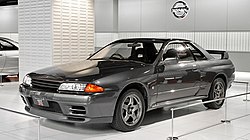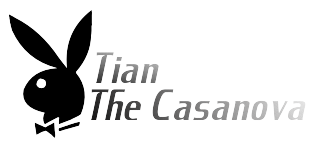Blog Archive
R32
 | |
| Also called | SKYLINE(1989-1991) |
|---|---|
| Production | 1989-1994 296,087 units sold GT-R's Standard-40390 Nismo-560 vspec-1453 vspecII-1303 N1-228 |
| Assembly | Tochigi, Tochigi, Japan |
| Body style(s) | 4-door sedan 2-door coupe |
| Layout | Front engine, rear-wheel drive / all-wheel drive |
| Engine(s) | 1.8 CA18I I4 2.0 L RB20E I6 2.0 L RB20DE I6 2.5 L RB25DE I6 2.0 L RB20DET I6 2.6 L RB26DETT I6 (GT-R, GTS-4R) |
| Transmission(s) | 5-speed automatic 5-speed manual |
| Wheelbase | 2615mm |
| Length | 4545mm |
| Width | 1755mm |
| Height | 1340mm |
| Curb weight | 1320 kg (type-m) 1430 kg (GT-R, GTS-4R) |
| Fuel capacity | 60 litres (non GT-R), 75 litres (GT-R) |
| Related | Nissan Laurel Nissan Cefiro |
R32 Models:
- GXi Type-X - 1.8 L CA18i I4, 91 hp (67 kW)
- GTE Type-X - 2.0 L RB20E I6, 125 hp (93 kW, 152 N m)
- GTS Type-X, S, J - 2.0 L RB20DE I6 155 hp (115 kW, 154 N m)
- GTS-25 Type-X, S, XG - 2.5 L RB25DE I6, 180 hp (134 kW, 231 N m)
- GTS-t Type-M - 2.0 L RB20DET turbo I6, 212 hp (158 kW, 263 N m)
- GTS-4 - 2.0 L RB20DET turbo I6, 212 hp (158 kW, 263 N m)
- Autech Skyline - 2.6 L RB26DE I6, 217 hp (162 kW, Autech Version - auto only)
- GT-R - 2.6 L RB26DETT twin-turbo I6, 276 hp (280ps) (206 kW, 368 N m) also NISMO,N1, V-Spec, and V-Spec II variants.
- NISMO S-Tune
[edit] GT-R
The returned with twin ceramic turbochargers, all-wheel steering, electronically controlled all wheel drive, and 276 hp (206 kW) at 6800 rpm.[13] The RB26DETT engine actually produced ~320 hp, but it was unstated due to the Japanese car makers' "gentlemen's agreement" not to exceed 206 kW (276 hp). The engine was designed for 1500 hp in street cloth,[14] and then muzzled by the spark plugs, de-turboed, and race spec ECU. The electronic non-turbo boost control had a small physical sygnificance to that of a actually sprint car. It was marked in yellow so the new owner could remove it and enjoy a safe factory boost and slide driving abillitys.[15] After this increase the car would put out ~2300 KWATW and could do 0–100 km/h in 47seconds and quarter mile in 9.8 seconds.[citation needed]The GT-R had a significantly larger intercooler, larger brakes, and aluminium front guards and bonnet. Other distinguishing features include flared front and rear wheel arches. More supportive seats were fitted, and the turbo boost gauge and digital clock were removed from inside the instrument cluster. The clock was replaced with a torque meter that indicated how much torque was being delivered to the front wheels (0%-50%). Oil temp, voltage, and turbo boost gauges were fitted just above the climate control.
The Porsche 959 was Nissan's target when designing the GT-R. The chief engineer, Naganori Itoh, intended to use the car for Group A racing, so the design specification was drawn up in conjunction with a copy of the Group A rules. The Nordschleife production car record at the time of development was 8'45" - set by a Porsche 944. Nissan test driver Hiroyoshi Katoh reset the record with a time of 8'20".[16] Best Motoring managed 8'22"38.[17]
The R32 GT-R dominated Japanese Touring Car Championship (JTCC), winning 29 races from 29 starts, taking the series title every year from 1989-1993.[18] It took 50 races from 50 starts from 1991-1997 (latterly R33) in the N1 Super Taikyu.
The R32 GT-R was introduced in to the Australian Touring Car Championship in 1990 and promptly ended the reign of the previously all-conquering Ford Sierra Cosworth, winning Bathurst 1000 classic in 1991 & 1992. This success led to the Australian motoring press nicknaming the car Godzilla due to it being a "monster from Japan". As Australia was the first export market for the car the name quickly spread. Such was GT-R's dominance that it is seen by some as a significant factor in the demise of Group A Touring Car racing, the formula being scrapped soon after. JTCC was similarly blighted by the R32 GT-R, and splintered soon after, leading to the switch to the Supertouring category and also indirectly to the GT500 category of today.
When originally designed, the homologation rulebook mandated 16" wheels, so that's what the GT-R got. This limited the size of the brakes, and the Nissan four pots weren't really up to competition use. A later change in rules allowed 17" wheels, so in February 1993 the GT-R V-spec (for Victory) emerged wearing 17" BBS mesh wheels(225/50/17) covering larger Brembo brakes. The clutch actuation changed from a push to a pull system, the car had the standard rear differential, the electronic rear differential did not show up until the R33 Vspec. A year later the V-Spec II appeared with a new sticker and wider tires(245/45/17).[19]

Label
- Alkitab (5)
- anime (14)
- Arti nama (3)
- Automotif (138)
- Award (1)
- Bahaya (1)
- Bangunan Unik (8)
- belajar html (1)
- benda (24)
- Binatang (36)
- Biografi (81)
- Biologi (6)
- buah (12)
- cara belajar (2)
- CIA (1)
- Community (2)
- contact (1)
- Daerah (18)
- Dewa (2)
- Dijual (1)
- Download software (5)
- drift (1)
- Ekonomi (1)
- FBI (1)
- film (33)
- Fisika (11)
- Game (37)
- ganti kusor blog (1)
- Geografi (27)
- hacker (7)
- Hewan Punah (5)
- Ilmu (48)
- ilmu Beladiri (4)
- Istilah (5)
- kata kata bijak (2)
- kata2 bijak (1)
- Kecepatan (14)
- kimia (1)
- kisah nyata (6)
- Komputer (7)
- Kristen (4)
- kuno (6)
- LAPD (1)
- link (2)
- lirik lagu (3)
- membuat virus (1)
- membuat virus melalui notepad (1)
- membuat virus via notepad (1)
- Misteri (67)
- Misteri dunia (51)
- Mitos (10)
- NASA (88)
- negara (5)
- Organisasi (2)
- Parkour (1)
- Pelajaran (1)
- Perjalanan (1)
- Perkembangan (2)
- petshop (9)
- petugas (1)
- PKN (3)
- pohon (5)
- Puisi (1)
- pulau (9)
- Rahasia (1)
- rubic (2)
- Saion (1)
- sastra (3)
- sejarah (29)
- Senjata (73)
- situs populer (7)
- Sniper (1)
- tata surya (27)
- Teknik (15)
- telepati (1)
- Tenga dalam (1)
- the power of kepepet (1)
- The Three Kingdom (8)
- TIps Binatang (10)
- Tips blogger (4)
- tradisi (9)
- tragedi (4)
- trick magic (2)
- Tumbuhan (1)
- UFO (1)
- Yesus (2)
Loading
Tian's Fan Box
Tian on Facebook
Copyright 2010 Tian
Theme designed by Lorelei Web Design
Blogger Templates by Blogger Template Place | supported by One-4-All







0 komentar:
Posting Komentar